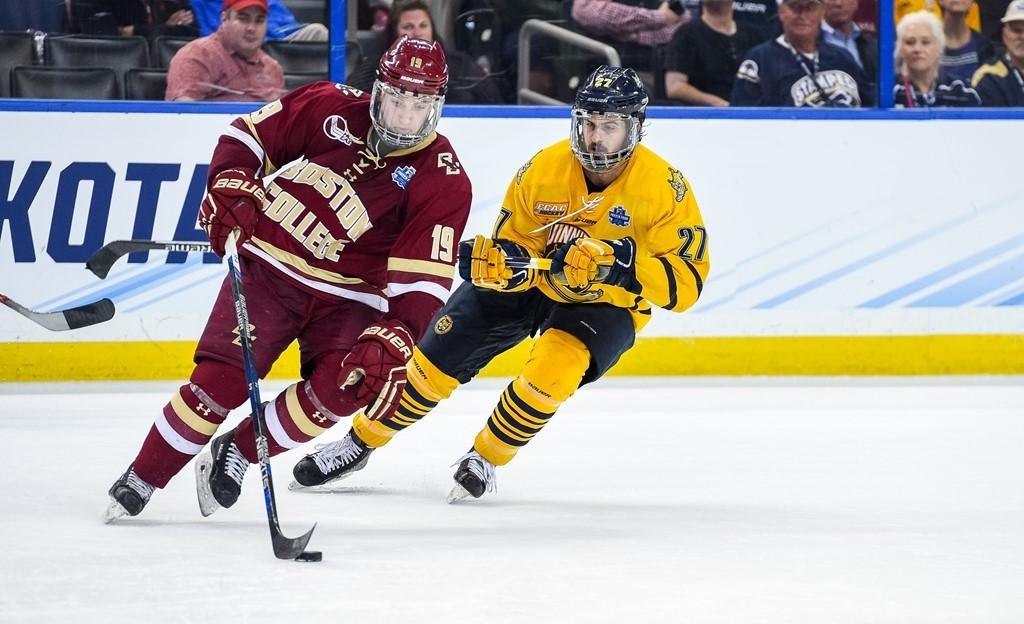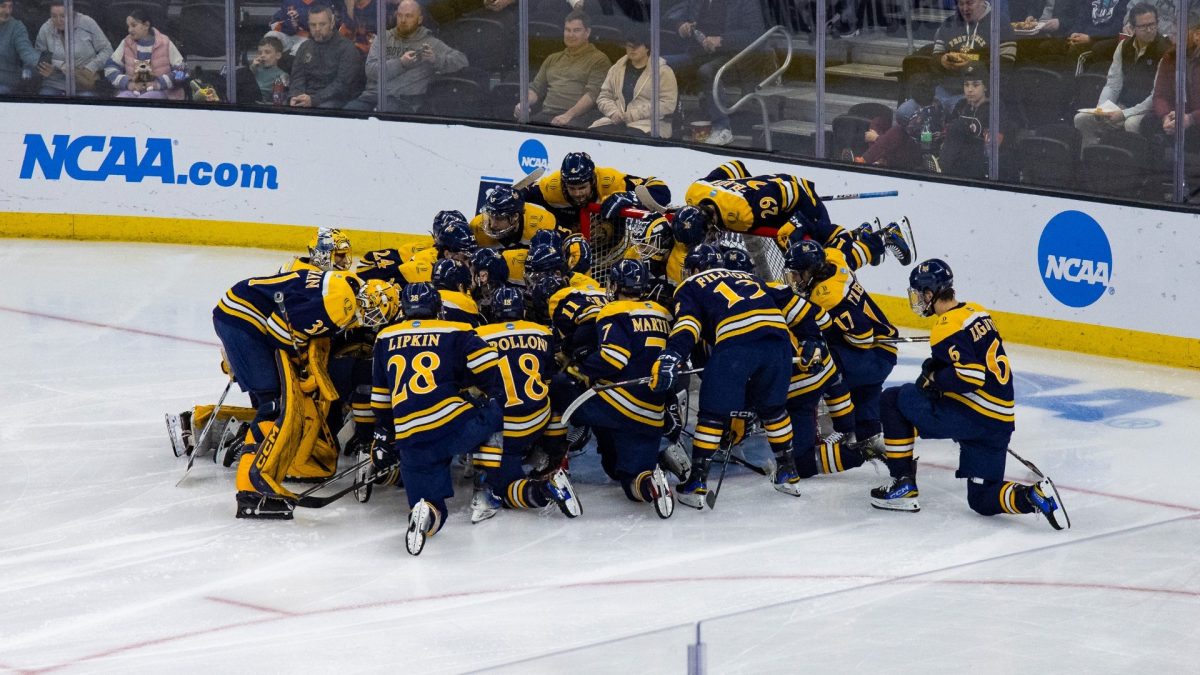Photo Courtesy: Quinnipiac Athletics
TAMPA – It’s early in the third period, Quinnipiac is holding onto a two-goal lead over Boston College. Bobcat defenseman Derek Smith crosses the centerline and dumps a puck cross corner to Thatcher Demko’s right. Four Bobcats forecheck the puck. Smith is the first man into the corner on the attack.
This has been a reoccurring trend for Quinnipiac this season. Using defensemen as extra forecheckers to cause confusion on the dump-and-chase has become the norm.
The Bobcat pressure is so extreme that sometimes it takes a team three or four chances to clear the puck from its defensive zone. When that is the case, more shots are going on net, and in turn more scoring opportunities are produced.
Connor Clifton is one of the Bobcat defenders who epitomizes the story.
Starting in the postseason, Clifton has recorded a team high 10 postseason points. The ECAC tournament most outstanding player and NCAA regional all tournament selection is on a tear. His one goal and nine assists are a direct result of the offensive play of the defensemen. Compare it to the Derek Smith example, which is only one of many. The defensemen, like Clifton, are racking up points as a result of their involvement in pressuring the offense.
Coming into the national semifinal, there was no reason for Rand Pecknold to change the team’s style. After all, the old saying “if it ain’t broke don’t fix it” fits perfectly well.
Boston College was well aware of the in-your-face style that Quinnipiac plays from all positions on the ice.
“They just made some good plays, and we turned the puck over,” Boston College head coach Jerry York said after Thursday’s game. “Both (goals) came off turnovers. Deep in our zone.”
But it wasn’t only the goals coming off of turnovers; it was the puck possession. Quinnipiac ranks among the college hockey elites in the ‘Corsi’ standings. ‘Corsi’ is essentially a statistic for measuring a team’s puck possession, and the Bobcats find themselves number four on the list nationwide.
Puck possession begins with getting the puck, pretty self explanatory. Getting the puck, however, a product of the lethal Quinnipiac forecheck. It is in the game plan from the start.
“They knew who our top guys were and what we were trying to do,” Boston College junior Steve Santini said after the game.
Not only did the Quinnipiac even strength pressure take a toll, but the special teams were also a factor, as they have been all season.
It is no secret that the Quinnipiac penalty kill is built to force pressure and mistakes. The Bobcats don’t play a standard box; they over-extend and pressure the puck.
On top of that, Quinnipiac has the stats to back its style up. The third best penalty kill in the nation belongs to the Bobcats. Registering at 89 percent, the unconventional penalty kill works for the Bobcats. Once again, no need to change something so successful.
“It’s kind of one go, we all go. Like we can’t have three guys going and the fourth guy not,” Rand Pecknold said.
Putting the penalty kill to the test against Boston College, a top ten power play team in the nation, was no easy task. Yet Quinnipiac while a man down again answered the call against the powerhouses of the Eagles.
“I thought they were very aggressive. They tracked the puck well. Took away some of our passing lanes,” York said in regards to the Quinnipiac penalty kill.
For Quinnipiac though, that is nothing out of the ordinary.
“We want to deny time and space,” Rand Pecknold said after the win, “You look at the talent, the firepower that BC has if you give those kids time they are going to make plays and we had to kind of get up in their face a little bit.”
That hard-nosed style is synonymous with Quinnipiac.
Players like Tim Clifton, Scott Davidson, Soren Jonzzon and Connor Clifton are some of the more physical fore-checkers on the team.
For the Bobcats, the offense begins with forcing turnovers. The shots, scoring opportunities, goals. They all start with pressing the opponent. The players know creating confusion for the opponent and disrupting the breakout, as simple as it sounds, are vital to success.
“If we succeed in the way we want to forecheck, it creates kind of chaos and it tips things in our direction,” Landon Smith said.
Chaos is perhaps an understatement. Whether it is a turnover, a broken-up breakout, or even simply an extra shot on net. Chaos is central to Quinnipiac’s success.
After all, one extra shot on net may not sound like the difference maker, and it likely is not. But when you repeat that process every time you attack, in the end you may get two or three extra scoring opportunities per period. Even if only one of those opportunities is capitalized on per game, then the system worked. Who knows, maybe that one goal is the difference between a piece of hardware and going home empty-handed.
The Bobcats aren’t the type of team to sit back and wait for turnovers to come to them. Rand Pecknold doesn’t want his forwards to play defensively all the time, no matter the score. It is about creating your own opportunities.
“We kept talking about not sitting back in a prevent defense. We want to go and really re-gap and push up,” Pecknold said. “We play to our identity, and we get rewarded.”
Boston College defenseman Ian McCoshen retrieves the Derek Smith dump and throws the it up the far side boards. Who is there to intercept? Derek Smith, a Bobcat defender. Smith throws the puck out front to a streaking Bobcat forward.
A quality shot on Thatcher Demko.
Forcing turnovers down low from a simple dump and chase? One word. Chaos.
Rewarded for causing chaos, if only it was that easy.
For Quinnipiac, the real reward comes on Saturday. As Travis St. Denis called it, “another kick at the can.”
The can? A chance at a national championship. Something the team’s seniors missed out on just three years ago.
This time, they pursue a much different fate. This time, Quinnipiac looks to capture the first national title in program history.






